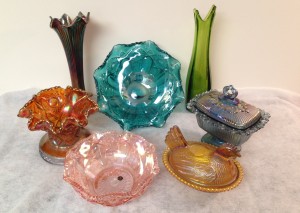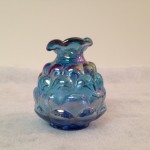We jumped at the chance to purchase this collection of vintage carnival glass from a client in Alexandria, Virginia, who won’t have space to display it in his new home. We picked up more than 40 pieces in all and began placing them for sale in our OrionsAttic eBay store on March 6, 2015. See the Decorative Glass section to soak it all in. We hope to have the whole collection up within a few more days, including some Depression glass that came with it.
My personal favorite so far is the L.E. Smith teal green carnival glass bowl. I’m not quite sure why that one grabs me. Maybe the color reminds me of the day I spent in Florida with my sister Heather, when I confronted my life-long fear of water by attaching myself to a teal dolphin who clearly sensed my terror and had a blast dragging me on a longer circuit than she took with other visitors. Scarlett was her name. I survived but I suspect she’s still laughing at the memory more than 15 years later. It cracks Heather up, too.
Won-ok’s favorite is the Fenton blue carnival glass miniature vase. She likes it because “it’s simply so beautiful and cute.” She has no trauma associated with her selection.
Our collection seems to be comprised by pieces from the “late carnival” period after 1940, which makes our offerings affordable to the beginning collector and the pro who is looking to pack more color on display shelves. Some of the pieces could be older, perhaps from the pre-1920 classic period, but we always choose to err on the side of conservative identification and pricing. Better for buyers to be pleasantly surprised by great value than feel disappointed by not enough.
For those new to this area of collecting, carnival glass is made by using a plunger to press molten glass into a mold. It is made into patterns and given a shiny, iridescent surface that appears to change color as you look at it from different angles. Metallic salts are added while the glass is still hot and then given another firing. This glass gets its name from the fact that it was sometimes given away as prizes at carnivals, though most apparently was purchased by women seeking to add color to their homes.
For people who haven’t yet had the pleasure of collecting carnival glass, check out Carnival Glass Association overview of the subject. You can also dig into carnival glass with the hefty online Field Guide to Carnival Glass by David Doty.
Do you have collections or entire homes full of items to sell? We’re always looking for antiques, rare books, collectibles, jewelry, furniture (contemporary and antique) and all kinds of other things. Contact Chris today to talk about estate sales, estate liquidations and more.



